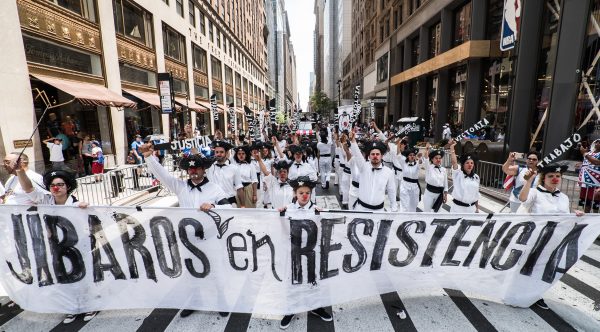

Pelotón Jíbaros en Resistencia joining the Puerto Rican Parade. Photo by Melvin Audaz
Forget about the elected officials, famous people or the few corporations that attended and participated in the National Puerto Rican Day Parade this past Sunday. This year, the buzz on Fifth Avenue was about groups —who through art and their activism— want to make an impact and speak up about the current situation in Puerto Rico.
One of those groups, El Pelotón Jíbaros(as) en Resistencia (Jíbaros Platoon in Resistance), performed for the first time ever at the 60th annual National Puerto Rican day parade last Sunday in New York City.
The Pelotón is a group of artists from Puerto Rico and New York City. Their objective is “to spread a message of justice, equality and of course, humor, while addressing new ways to provoke the discussion of the hardships Puerto Rico is facing.”
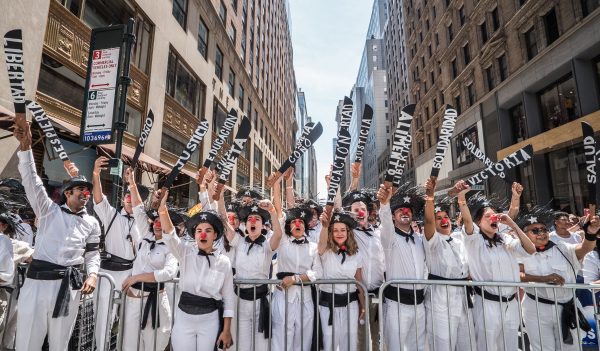

Jíbaros waiting for the parade to start. Photo by Melvin Audaz.
Hours Before the Parade
It is nine o’clock in the morning on a hot cloudless Sunday. A group of around 30 people gather on 45th Street between Fifth and Madison Avenues for their very first parade appearance. With their white uniforms and black neckties, these Jíbaros put on their black “pavas” (hats) and their red noses made of plastic. They tie up their wooden machetes on their hips with a black piece of cloth for a belt.
“¡Atención!” the platoon commander yells
“¡Wepa!” the group respond.
The Jíbaros line up to start their military salute. They call it “el saludo emperrifollao,” another word for attractive or elegant. After the salute, the commander gives orders to the Jíbaros to display their machetes. They put them up and down, and then back to their hips.
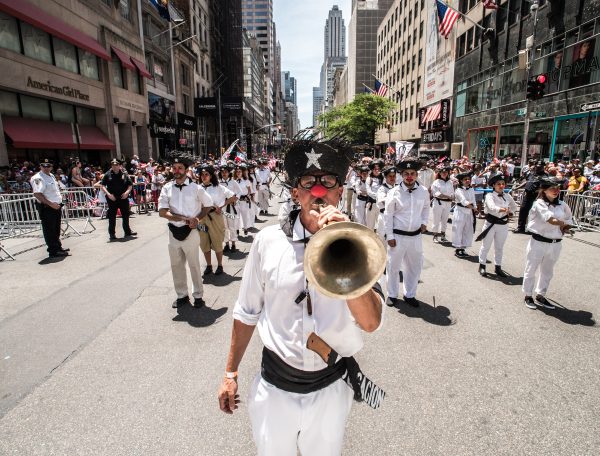

Israel Lugo leading the platoon of Jíbaros. Photo by Melvin Audaz.
Who Are Jíbaros?
Jíbaros refer to the people from the island’s mountain regions who cultivated different crops, like coffee and sugar cane. The Jíbaro figure is iconic in Puerto Rican culture and history. It has become a symbol of resistance and “lucha.”
“We are bringing back this traditional figure thinking of the nostalgia carried by the diaspora and the Puerto Ricans who left the island, and have forgotten about this iconic figure of the countrymen of our island. So we are bringing back that image,” said Israel Lugo, 43, one of the creators of this platoon, as he was wrapping up with the group’s first practice session two days before the parade.
Lugo’s idea was inspired from “La Unidad de Operaciones Tácticas de los Payasos Policías (The Tactical Operations Unit of Police Clowns), a group he created with Youset Soto, Roy Sánchez, Andrea and others back in Puerto Rico during the midst of the 2010 students’ strike at the University of Puerto Rico (UPR).
“We arrived to where la Fuerza de Choque [Puerto Rican Police specialized in crowd control] was. We stood next to them as if we were part of them and started performing,” Lugo said.
Seven years later, the Police Clowns returned this past May to join the Puerto Rico’s national strike against the island’s austerity measures and fiscal control board, also known as La Junta—a seven-member committee created in 2016 intended to fix and restructure the island’s $70 billion debt. However, the board is cutting funds and increasing the price of essential services for Puerto Ricans.
With their street performance, this clown police unit “attacks the situation with humor. By using words and with an artistic presence, we want to make sure people are cooled off [during protests] where there is no violence, where whoever is protesting forgets about that rock he or she was going to throw at the police officer and vice versa,” Lugo explained.
Back to the Parade
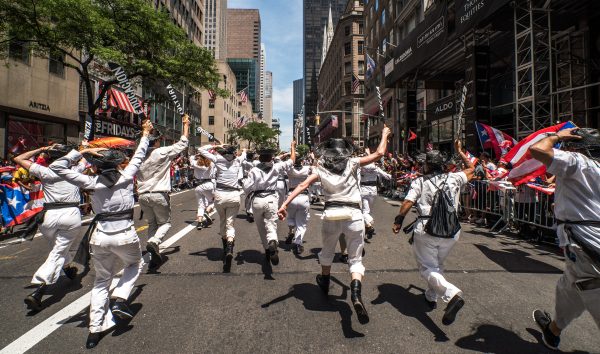

The Jíbaros in the resistance on Fifth Avenue. Photo by Melvin Audaz
It gets closer to noon. The parade is about to start.
Three Jíbaros at the front of the platoon holding a big banner that says “Jíbaros en Resistencia” start walking. Behind them, Commander Lugo, Soto and Sánchez lead the four lines of Jíbaros that form the platoon. Two more Jíbaros stand behind the four lines holding two flags with a Quinqué drawn on each of them. The Quinqué is an oil lamp used by the Jíbaros in the countryside. It represents the humility in which Jíbaros used to live.
As they march like soldiers, the people in the crowd on each side of Fifth Avenue echo the messages they see on the machetes that the Jíbaros hold. One lady chants “Sí a la Educación, Democracía, Justicia-Puñeta!” Others in the crowd seemed confused about the customs. They think the group is a bunch of pirates.
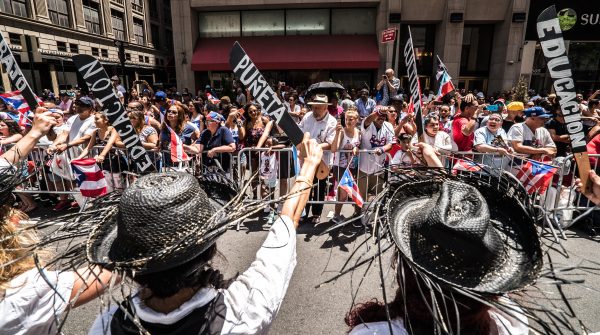

Jíbaros using their machetes at the parade. Photo by Melvin Audaz
Prepping for the Big Day
Two days before the parade, artists met at the Johnson Community Center in East Harlem to create and practice the choreographies they would perform at the parade. They also met at a parking lot near the gym to paint the machetes and pavas.
They did some theater techniques that helped them connect with each other. They laughed and cried as Lugo led an activity where they would have to change their emotions. Lugo also pushed the group to think about nostalgic and prideful moments—and even about the hardships the island is going through right now.
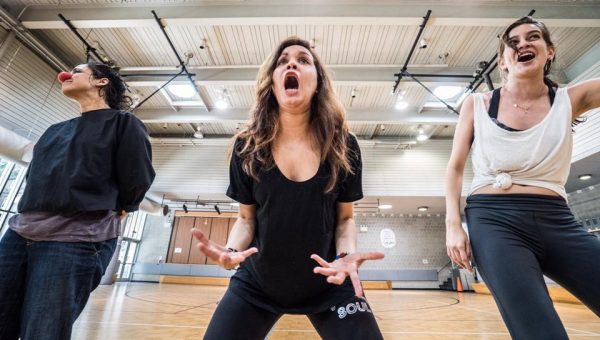

One training session before the parade. Photo by Melvin Audaz
For some of the members, it was their first time doing acting and street art.
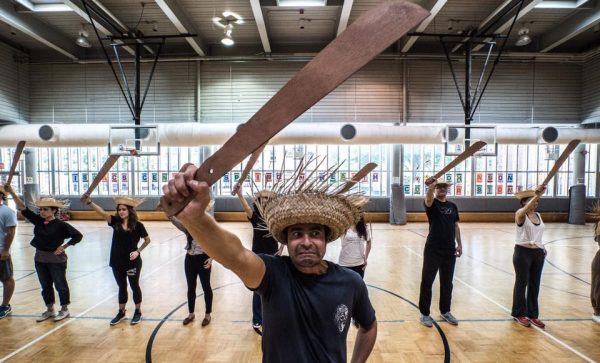

Roy Sánchez leading choreography. Photo by Melvin Audaz
Other members knew each other from before. They studied together at the University of Puerto Rico (UPR) and kept working together on their careers as actors.
Yaraní del Valle Piñero, 40, is one of the Jíbaras. A New Yorker native who was raised in Puerto Rico, she went to UPR with Lugo and others in the platoon.
“La Junta is cutting funds to our university! How are we going to overcome these times? Our students are the future and solution of our island” Piñero said. “That’s the place where it all started.”
“It is important that people see that the situation in Puerto Rico is hard but that we artists are facing it in a positive way,” she added. “We the Jíbaros represent the unity of the people and with our machetes which represents our fight, will lead to our justice in our land.”
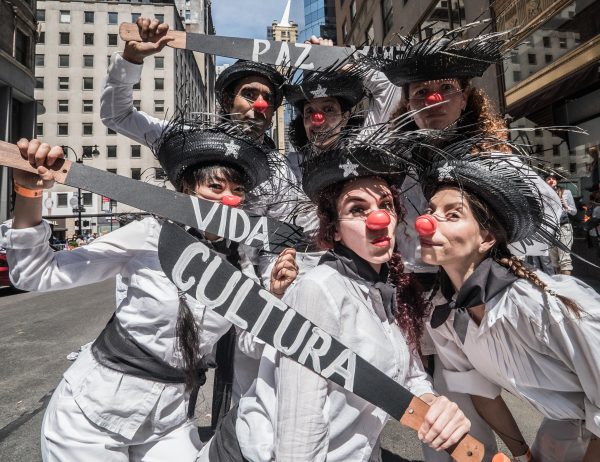

Yarani del Valle Piñero (right) and other Jíbaras holding their machetes. Photo by Melvin Audaz
After the Parade Ended
With the parade almost over, the platoon approaches 76th street. Sweating and almost dehydrated, they head to La Marqueta, an outdoor marketplace in East Harlem, to do one last performance in front of a small crowd of people who went to see Oscar López Rivera give a speech.
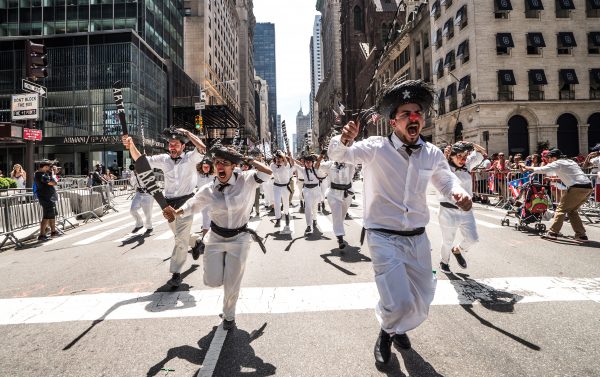

Jíbaros resisting on fifth avenue. Photo by Melvin Audaz.
For now, this Pelotón “will not rest until their land is treated with respect and equality because with red nose and machete the future won’t be ‘al garete’ (messed up)” and will continue to send a message of unity because “when Puerto Ricans come together, they can accomplish everything,” Lugo said.
***
María Camila Montañez is a journalism student at CUNY Graduate School of Journalism’s Spanish-language program. She is originally from Colombia and tweets from @mariacmontanez.


